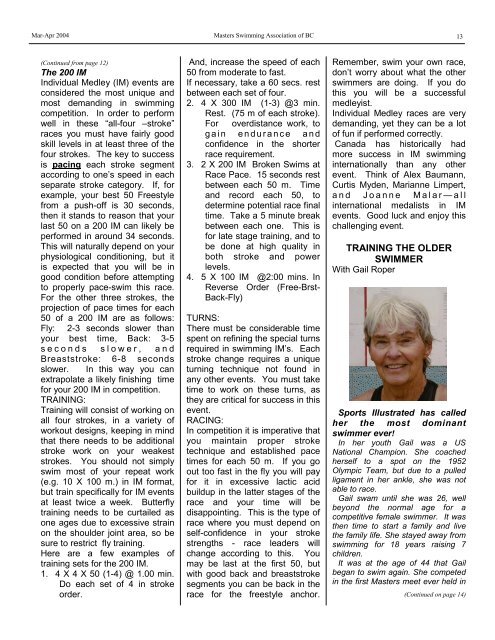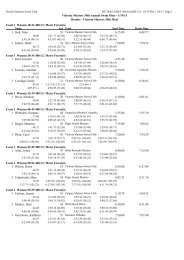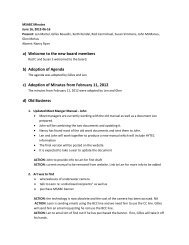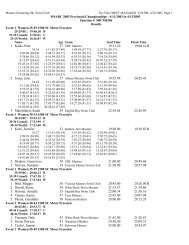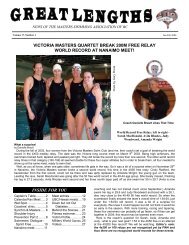Great Lengths - Masters Swimming Association of British Columbia
Great Lengths - Masters Swimming Association of British Columbia
Great Lengths - Masters Swimming Association of British Columbia
Create successful ePaper yourself
Turn your PDF publications into a flip-book with our unique Google optimized e-Paper software.
Mar-Apr 2004<br />
<strong>Masters</strong> <strong>Swimming</strong> <strong>Association</strong> <strong>of</strong> BC 13<br />
(Continued from page 12)<br />
The 200 IM<br />
Individual Medley (IM) events are<br />
considered the most unique and<br />
most demanding in swimming<br />
competition. In order to perform<br />
well in these “all-four –stroke”<br />
races you must have fairly good<br />
skill levels in at least three <strong>of</strong> the<br />
four strokes. The key to success<br />
is pacing each stroke segment<br />
according to one’s speed in each<br />
separate stroke category. If, for<br />
example, your best 50 Freestyle<br />
from a push-<strong>of</strong>f is 30 seconds,<br />
then it stands to reason that your<br />
last 50 on a 200 IM can likely be<br />
performed in around 34 seconds.<br />
This will naturally depend on your<br />
physiological conditioning, but it<br />
is expected that you will be in<br />
good condition before attempting<br />
to properly pace-swim this race.<br />
For the other three strokes, the<br />
projection <strong>of</strong> pace times for each<br />
50 <strong>of</strong> a 200 IM are as follows:<br />
Fly: 2-3 seconds slower than<br />
your best time, Back: 3-5<br />
seconds slower, and<br />
Breaststroke: 6-8 seconds<br />
slower. In this way you can<br />
extrapolate a likely finishing time<br />
for your 200 IM in competition.<br />
TRAINING:<br />
Training will consist <strong>of</strong> working on<br />
all four strokes, in a variety <strong>of</strong><br />
workout designs, keeping in mind<br />
that there needs to be additional<br />
stroke work on your weakest<br />
strokes. You should not simply<br />
swim most <strong>of</strong> your repeat work<br />
(e.g. 10 X 100 m.) in IM format,<br />
but train specifically for IM events<br />
at least twice a week. Butterfly<br />
training needs to be curtailed as<br />
one ages due to excessive strain<br />
on the shoulder joint area, so be<br />
sure to restrict fly training.<br />
Here are a few examples <strong>of</strong><br />
training sets for the 200 IM.<br />
1. 4 X 4 X 50 (1-4) @ 1.00 min.<br />
Do each set <strong>of</strong> 4 in stroke<br />
order.<br />
And, increase the speed <strong>of</strong> each<br />
50 from moderate to fast.<br />
If necessary, take a 60 secs. rest<br />
between each set <strong>of</strong> four.<br />
2. 4 X 300 IM (1-3) @3 min.<br />
Rest. (75 m <strong>of</strong> each stroke).<br />
For overdistance work, to<br />
gain endurance and<br />
confidence in the shorter<br />
race requirement.<br />
3. 2 X 200 IM Broken Swims at<br />
Race Pace. 15 seconds rest<br />
between each 50 m. Time<br />
and record each 50, to<br />
determine potential race final<br />
time. Take a 5 minute break<br />
between each one. This is<br />
for late stage training, and to<br />
be done at high quality in<br />
both stroke and power<br />
levels.<br />
4. 5 X 100 IM @2:00 mins. In<br />
Reverse Order (Free-Brst-<br />
Back-Fly)<br />
TURNS:<br />
There must be considerable time<br />
spent on refining the special turns<br />
required in swimming IM’s. Each<br />
stroke change requires a unique<br />
turning technique not found in<br />
any other events. You must take<br />
time to work on these turns, as<br />
they are critical for success in this<br />
event.<br />
RACING:<br />
In competition it is imperative that<br />
you maintain proper stroke<br />
technique and established pace<br />
times for each 50 m. If you go<br />
out too fast in the fly you will pay<br />
for it in excessive lactic acid<br />
buildup in the latter stages <strong>of</strong> the<br />
race and your time will be<br />
disappointing. This is the type <strong>of</strong><br />
race where you must depend on<br />
self-confidence in your stroke<br />
strengths - race leaders will<br />
change according to this. You<br />
may be last at the first 50, but<br />
with good back and breaststroke<br />
segments you can be back in the<br />
race for the freestyle anchor.<br />
Remember, swim your own race,<br />
don’t worry about what the other<br />
swimmers are doing. If you do<br />
this you will be a successful<br />
medleyist.<br />
Individual Medley races are very<br />
demanding, yet they can be a lot<br />
<strong>of</strong> fun if performed correctly.<br />
Canada has historically had<br />
more success in IM swimming<br />
internationally than any other<br />
event. Think <strong>of</strong> Alex Baumann,<br />
Curtis Myden, Marianne Limpert,<br />
and Joanne Malar—all<br />
international medalists in IM<br />
events. Good luck and enjoy this<br />
challenging event.<br />
TRAINING THE OLDER<br />
SWIMMER<br />
With Gail Roper<br />
Sports Illustrated has called<br />
her the most dominant<br />
swimmer ever!<br />
In her youth Gail was a US<br />
National Champion. She coached<br />
herself to a spot on the 1952<br />
Olympic Team, but due to a pulled<br />
ligament in her ankle, she was not<br />
able to race.<br />
Gail swam until she was 26, well<br />
beyond the normal age for a<br />
competitive female swimmer. It was<br />
then time to start a family and live<br />
the family life. She stayed away from<br />
swimming for 18 years raising 7<br />
children.<br />
It was at the age <strong>of</strong> 44 that Gail<br />
began to swim again. She competed<br />
in the first <strong>Masters</strong> meet ever held in<br />
(Continued on page 14)


